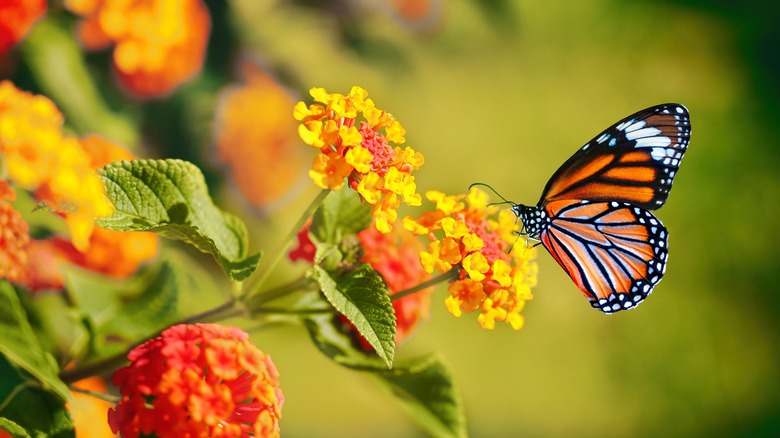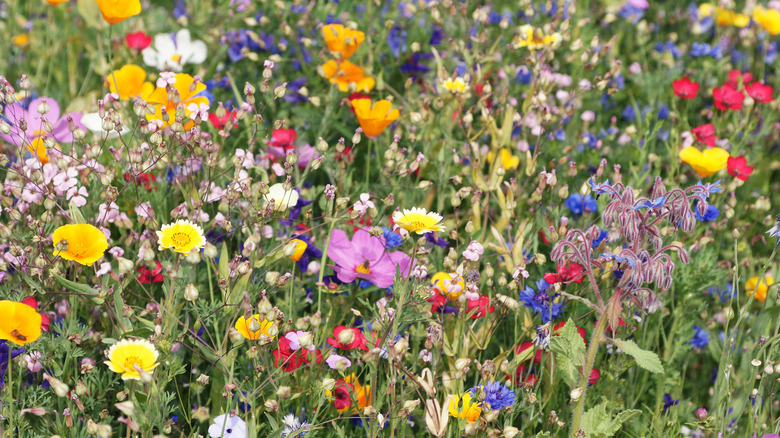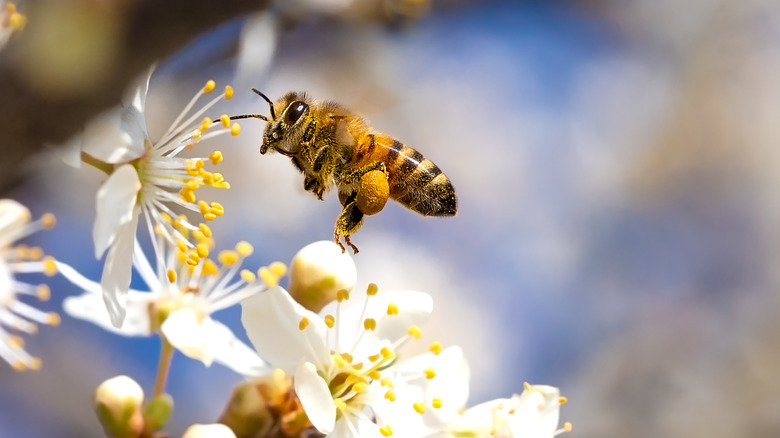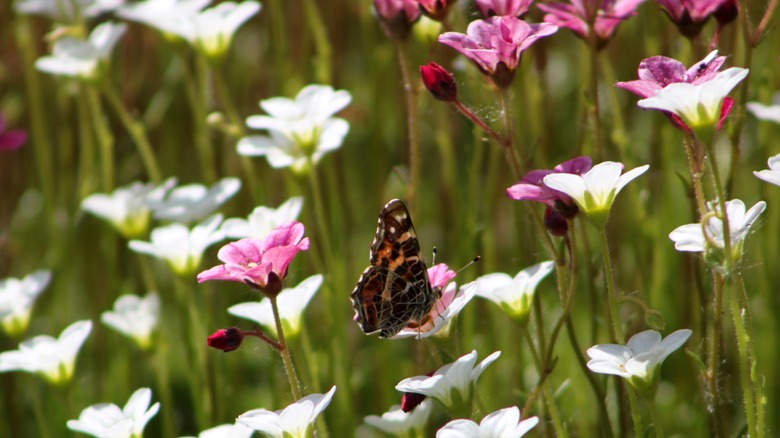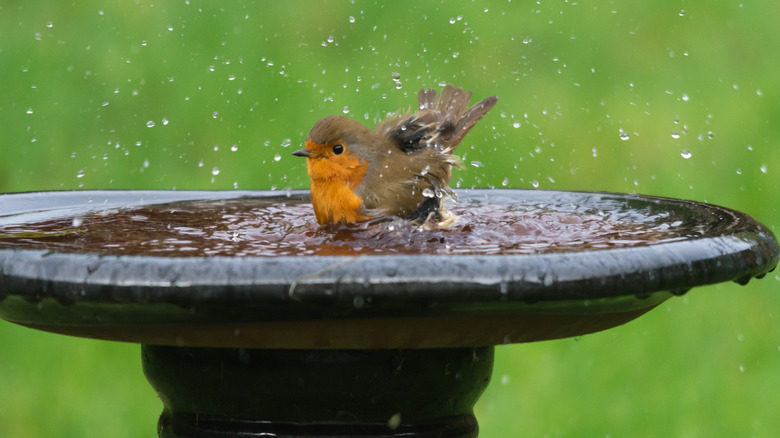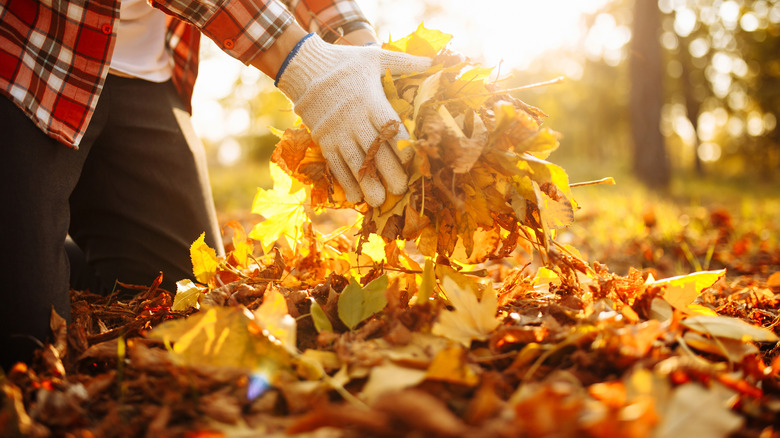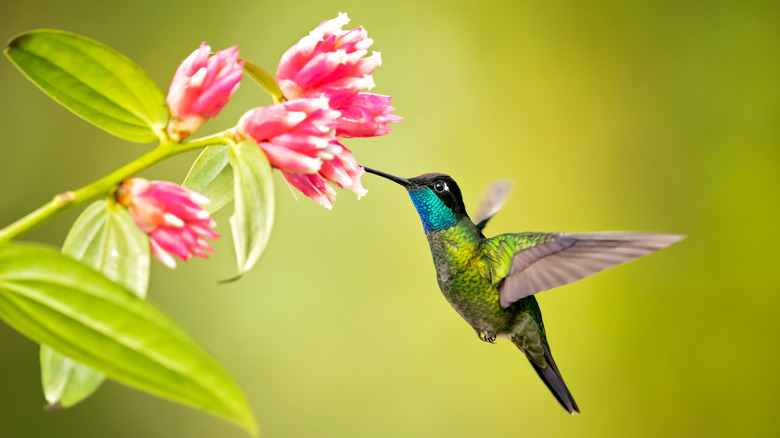How To Bring More Pollinators Into Your Yard And Garden, According To An Expert - Exclusive
Pollinator gardens have trended in recent years as people forgo traditional grass yards for biodiverse landscapes that promote local pollinator populations. Dr. Charles van Rees, a professional naturalist and conservation biologist, explains the importance of pollinators in an exclusive interview with House Digest. "Pollinators are globally important; without them, our ecosystems and, importantly, our agricultural systems, would come to a grinding halt. A great many important crops rely on pollinators to reproduce and to yield their important products."
Dr. van Rees blogs about outdoor science on his website Gulo in Nature and encourages people to help their local pollinators. This may include various species of butterflies, birds, bees, bats, moths, and small mammals, according to Pollinator Partnership. Thankfully, you don't need to live on or near a farm for your yard and garden to help local pollinators or even local crops.
"By taking some simple steps in your own garden, you can invite more pollinators to your outdoor space," Dr. van Rees says. "By doing this, you'll not only get to enjoy watching beautiful and interesting animals from the comfort of your home, but you'll also be doing your part to support your local wildlife."
Reduce their commute
First, you want to make your yard as attractive to pollinators as possible. "If a pollinator can get flower nectar in your yard, but also other food sources, a place to sleep, or even to build a nest and raise babies, they'll be more likely to show up and hang around," Dr. Charles van Rees explains. "Using a bee hotel or a pile of rocks or firewood to provide [a] nesting habitat will go a long way in attracting bees. Butterflies and moths, meanwhile, need host plants on which to lay eggs."
For example, milkweed is the only plant monarch caterpillars eat and is also where they lay their eggs. Thus, planting an abundance of milkweed will do wonders for the monarch population.
But insects aren't the things you should focus on in your yard. "Hummingbirds may need sheltered or safe places to perch and rest," says Dr. van Rees. "They tend to like dense shrubs and tall trees where they can get a wide view of the yard to survey for predators and rival hummers. Hummingbirds can be very territorial, so if you get a pair to move in, they might kick other hummers out!"
Keep them safe
Once you get pollinators to see your yard as a friendly place to hang out, you'll want to ensure they're safe while they visit or live on your property. "Insect pollinators are sensitive to herbicides and pesticides, and will be wiped out quickly if you rely on these chemicals to control pests," warns Dr. Charles van Rees. "Look for more sustainable alternatives whenever possible."
Thankfully, you need not rely on harsh chemicals to keep your yard's pest population down. Certain flowers and herbs that you can plant in your garden will deter unwanted pests like mosquitos, snails, and silverfish without harming pollinators. That being said, you should be careful about using other bugs or mammals as pest control.
"Introducing predators, especially non-native ones like the commercially available Chinese mantis, is also a major threat and can reduce the number of insect pollinators you find on your property," says Dr. van Rees. "Likewise, cats can be a major problem for hummingbirds, killing adults and raiding nests. If you have a cat, be mindful of what times of day or year you let them roam freely outside to minimize the damage."
Provide a good spread
When choosing the right native plants for your garden, biodiversity should be a top priority. Not only to make your yard a more beautiful place but to help feed the tireless critters that pollinate the area.
"Just like we like to eat a lot of different foods, nectar-feeding pollinators need a variety of nectar sources," explains Dr. Charles van Rees. "This is important not only to help them get the range of nutrients that they need, but also so that nectar is available at different times of the season and not all at once."
Planting a variety of flowers doesn't only offer your yard lots of bright colors. It helps native pollinator populations thrive. "By planting a range of flower species that bloom at different times throughout the spring, summer, and fall, you can do a lot to bring bees to your yard and keep them happy and healthy," says Dr. van Rees. "Hummingbirds often have very particular tastes in flowers, and some will attract them more than others. If you designate a few wildflower beds in your garden, you will quickly start to see a more active and diverse pollinator community."
Provide water
Nectar from a variety of flowers isn't the only source of vitality for pollinators. Ponds and bird baths in your yard are an easy solution for them to stop by for a quick drink. Even small bowls of water can be beneficial. "All pollinators need to drink water to keep going, so this is a non-negotiable for them," Dr. Charles van Rees says. "If you don't provide it in your yard, they'll have to get it elsewhere, and that may determine where they spend their time. At the very least, it will increase their commute."
Sugar water in a hummingbird feeder can provide nutrients and water to those lovable little birds while providing you with wildlife to admire from your window or patio. "Hummingbirds and plenty of other non-pollinator birds will show up to any water source," Dr. van Rees explains. "It's a cheap and easy way to get a lot of great wildlife sightings, especially if it's a dry time of year. I recommend putting the water source somewhere that you can view it from indoors; you'll be surprised who shows up."
Help them through the winter
Just as most people don't like being outside during the winter, neither do pollinators. Some don't migrate, however, so they'll need a little help to make it through the season. "Pollinator insects like butterflies, moths, beetles, flies, and butterflies have to survive the winter," explains Dr. Charles van Rees. "If you want to see more of them in your yard, it's a good idea [to] help them get through to the next spring."
Thankfully, making your winter landscape more appealing to pollinators isn't rocket science. In fact, there's a simple way you can create makeshift winter homes for pollinators in your yard.
"Try leaving leaf piles in the corner of your yard or not raking certain areas in the fall," suggests Dr. van Rees. "Many insects, at some point in their life cycle (sometimes as adults, larvae, pupae, or eggs) overwinter in leaf litter. By leaving this intact, you've got a ready-made menagerie of fantastic pollinators ready to come out in force when it gets warm and the flowers come out again."
Help them during shoulder seasons
Everyone knows how hungry one can get in the middle of a long road trip. Migrating pollinators are no different, so consider providing them with a tasty bite to eat during their long journeys.
"For migratory pollinators like hummingbirds and larger butterflies, make sure your collection of flowers includes ones that will bloom early in the spring and late in the fall," Dr. Charles van Rees explains. "Having nectar sources in the 'shoulder seasons' can be a big help for these pollinators."
Shoulder seasons are weeks or months that come in between the main growing season, according to Backyard Ecology. The exact time of a shoulder season depends on where you live, and your location will also determine what to plant to get those early and late-season blooms.
However, you don't have to rely on plants alone to bring pollinators back to your yard at the end of the winter. "Hummingbird feeders are, of course, an easy way to give hummers a leg up when they first arrive in early spring," Dr. van Rees says.
